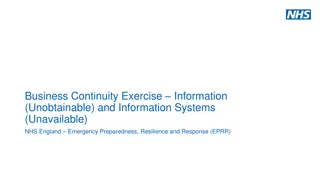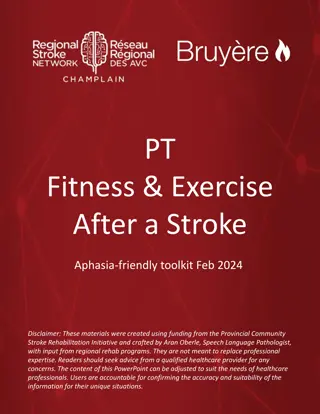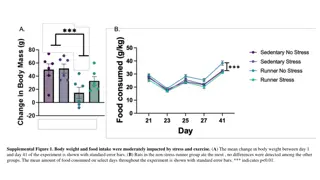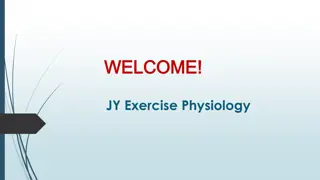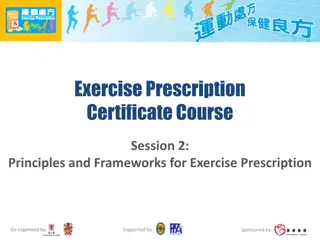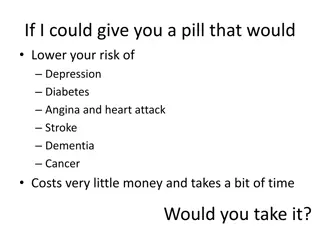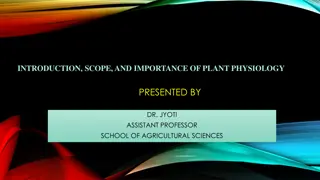Understanding Exercise Physiology Fundamentals
Explore the basics of exercise physiology, including physiologic responses to acute exercise, functional adaptations to chronic exercise, and the mediation of health effects. Learn the difference between physical activity and exercise, the concept of work in exercise, and the energy expenditure involved. Dive into the metabolic breakdown of energy sources, such as carbohydrates, proteins, and fats, to produce ATP and support muscle contraction and other essential functions. Understand key terms like VO2, MET, and more that are crucial in the study of exercise physiology.
Download Presentation

Please find below an Image/Link to download the presentation.
The content on the website is provided AS IS for your information and personal use only. It may not be sold, licensed, or shared on other websites without obtaining consent from the author. Download presentation by click this link. If you encounter any issues during the download, it is possible that the publisher has removed the file from their server.
E N D
Presentation Transcript
EXERCISE PHYSIOLOGY 101 EXERCISE PHYSIOLOGY 101 Russell R. Pate, PhD Arnold School of Public Health University of South Carolina
Topics Topics Physiologic responses to acute exercise Functional adaptations to chronic exercise Mediation of health effects of exercise
PHYSIOLOGIC RESPONSES TO PHYSIOLOGIC RESPONSES TO ACUTE EXERCISE ACUTE EXERCISE
Physical Activity Any bodily movement produced by skeletal muscle that requires energy expenditure Exercise Physical activity that is planned, structured and repetitive that has an objective the improvement of physical fitness.
Involves WORK Work = Force x Distance (kg m) (kg) (m)
60 kg man steps up 0.25 meters Step Height Work = 60 kg x 0.25 m = 15 kg m 426.8 kg m = 1 kcal
Work Requires Energy Expenditure Work Requires Energy Expenditure
Energy Expenditure Energy Expenditure Involves metabolic breakdown of food-derived energy stores to produce ATP Energy can be expended aerobically or anaerobically
ANAEROBIC CARBOHYDRATES AEROBIC PROTEIN FATS O2 CO2 ATP H2O LACTIC ACID ATP ATP ADP + P + Muscle Contraction, Biosynthesis, Active Transport
VO VO2 2 Rate at which oxygen is consumed by the body (ml O2/kg body mass/min)
MET MET A Metabolic Equivalent Unit Used to estimate the rate of energy expenditure during physical activity relative to resting metabolic rate (1 MET) 1 MET = 3.5 ml O2/kg body mass/min
Aerobic Energy Expenditure During Graded Aerobic Energy Expenditure During Graded Treadmill Exercise Treadmill Exercise Maximal exercise 60 16 14 50 12 40 Energy Expenditure (kcal/min) & METS 10 VO2 (ml O2/kg body mass/min) 30 8 6 20 VO2 (ml/kg/min) 4 METS 10 2 EE (kcals/min) 0 0 Walk/Run Speed
Different activities require varying Different activities require varying rates of energy expenditure rates of energy expenditure
Energy Expenditure (METS) 0 2 4 6 8 10 12 14 16 18 20 22 24 Sleeping Sitting Standing Walking 3.5mph Cycling 5.0mph Tennis Cycling 7.5mph Weight Lifting Basketball Handball Wrestling Running 7.5mph Running 10.0mph Swimming 3.0mph 0 5 10 15 20 25 30 Energy Expenditure (kcal/min)
VO VO2 2 Increased VO2 during physical activity requires increased cardiorespiratory function to support increased O2 delivery to active muscle VO2 = Q A VO2 Q = HR SV Q = cardiac output; HR = heart rate; SV = stroke volume A VO2 = Arteriovenous Oxygen Difference
Cardiovascular response to graded Cardiovascular response to graded exercise exercise Stroke Volume (ml/beat) 200 22 HR 20 175 Heart Rate (beats/min) 18 150 Cardiac Output 16 Q (liters/min) 125 14 12 100 10 SV 75 8 50 6 25 4 2 0 Rest Stage 1 Stage 2 Stage 3 Max Bruce Protocol
SUMMARY Physical activity involves work, and energy expenditure is required to support that work Muscles can produce energy through either aerobic or anaerobic metabolic processes Different forms of physical activity require widely varying rates of energy expenditure (VO2, METs, Kcal/min) During physical activity adjustments in cardiovascular function are needed to support increased energy expenditure
FUNCTIONAL ADAPTATIONS FUNCTIONAL ADAPTATIONS TO TO CHRONIC EXERCISE CHRONIC EXERCISE
VO VO2max 2max Greatest rate at which O2 is consumed during exhaustive exercise www.cadancecycling.com
Chronic Aerobic Exercise Chronic Aerobic Exercise Increases cardiorespiratory fitness (VO2max) (e.g. functional capacity) Exercise to higher maximal intensities Exercise longer at standard and relative submax intensity Less fatigue (RPE) at standard or relative submax intensity
VO VO2max 2max Results From Results From Increased Blood Volume Increased venous return Increased SV Increased Qmax Skeletal Muscle Adaptation Increased (a-v)O2Diff Increased Enzymes of Aerobic Metabolism Increased Myoglobin
Chronic Aerobic Exercise Chronic Aerobic Exercise Modifies metabolic function fat metabolic capacity Lactate accumulation Enhances efficiency O2 needed for a given exercise intensity Cardiac work needed for a given exercise intensity
SUMMARY Chronic exposure to aerobic exercise increases cardiorespiratory fitness A key adaptation is increased VO2max Supporting adaptations include Increased blood volume, SV, Qmax Enhanced muscle metabolic function Improved efficiency
MEDIATION OF HEALTH MEDIATION OF HEALTH EFFECTS OF EXERCISE EFFECTS OF EXERCISE
Health & fitness effects of PA are related to Health & fitness effects of PA are related to chronic dose or a change in chronic dose chronic dose or a change in chronic dose 100 75 Relative Risk of Heart Attack in Percent 50 25 0 0 1000 2000 3000 4000 5000 Physical Activity Index in KCAL per week
Mechanisms Underlying Health Mechanisms Underlying Health Effects of Chronic Exercise Effects of Chronic Exercise Muscle Muscle Mass Resting Metabolic Rate Fitness Insulin Sensitivity GLUT-4 Translocation Blood Glucose
Mechanisms Underlying Health Mechanisms Underlying Health Effects of Chronic Exercise Effects of Chronic Exercise Cardiovascular System Cardiac Function Stroke Volume Max Cardiac Output Resting Blood Pressure
Mechanisms Underlying Health Mechanisms Underlying Health Effects of Chronic Exercise Effects of Chronic Exercise Metabolism/Immune Function HDL Cholesterol Triglycerides C-Reactive Protein
Mechanisms Underlying Health Mechanisms Underlying Health Effects of Chronic Exercise Effects of Chronic Exercise Skeleton Bone Mineral Density G-I System Intestinal Transit Time
SUMMARY Health effects of chronic exercise are driven by increased caloric thru-put (energy expenditure) Key adaptive mechanisms: Increased muscle mass Increased insulin sensitivity Enhanced cardiovascular function Reduced resting blood pressure Improved blood lipid profile Enhance immune function Increased bone mineral density
http://www.healthyeating.org/Portals/0/Gallery/Album/Healthy%20Eating/senior%20couple%20stretching%20small.jpghttp://www.healthyeating.org/Portals/0/Gallery/Album/Healthy%20Eating/senior%20couple%20stretching%20small.jpg


